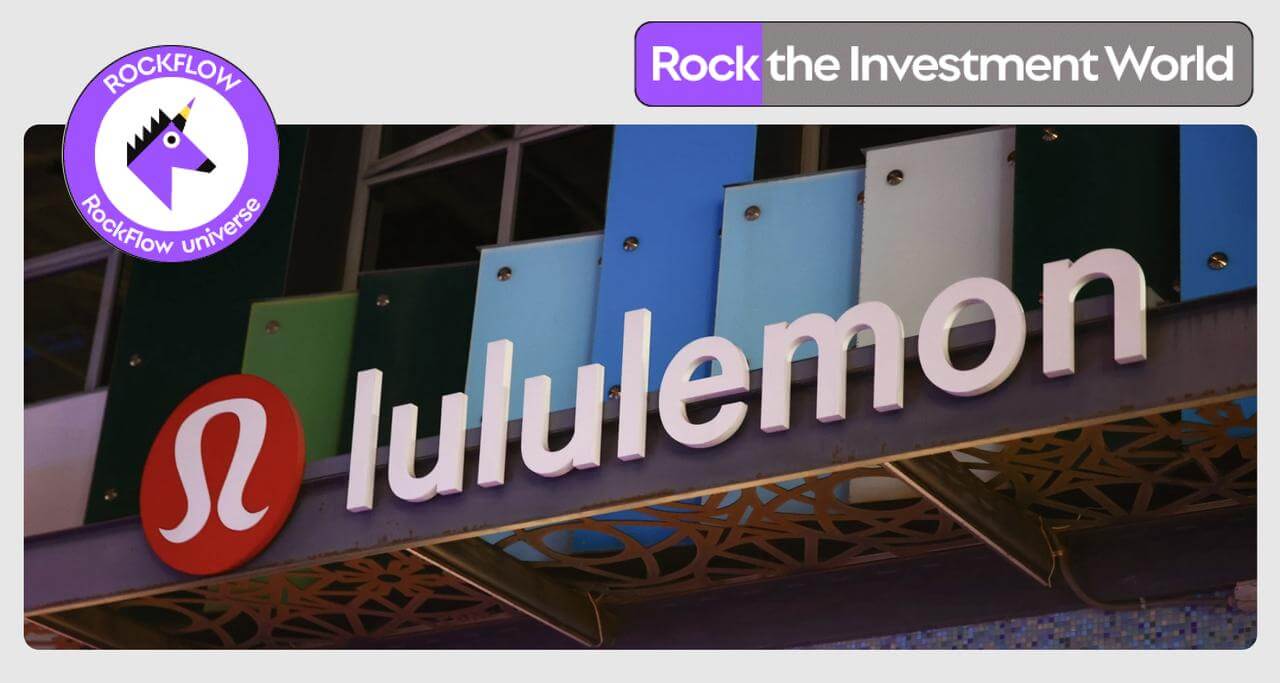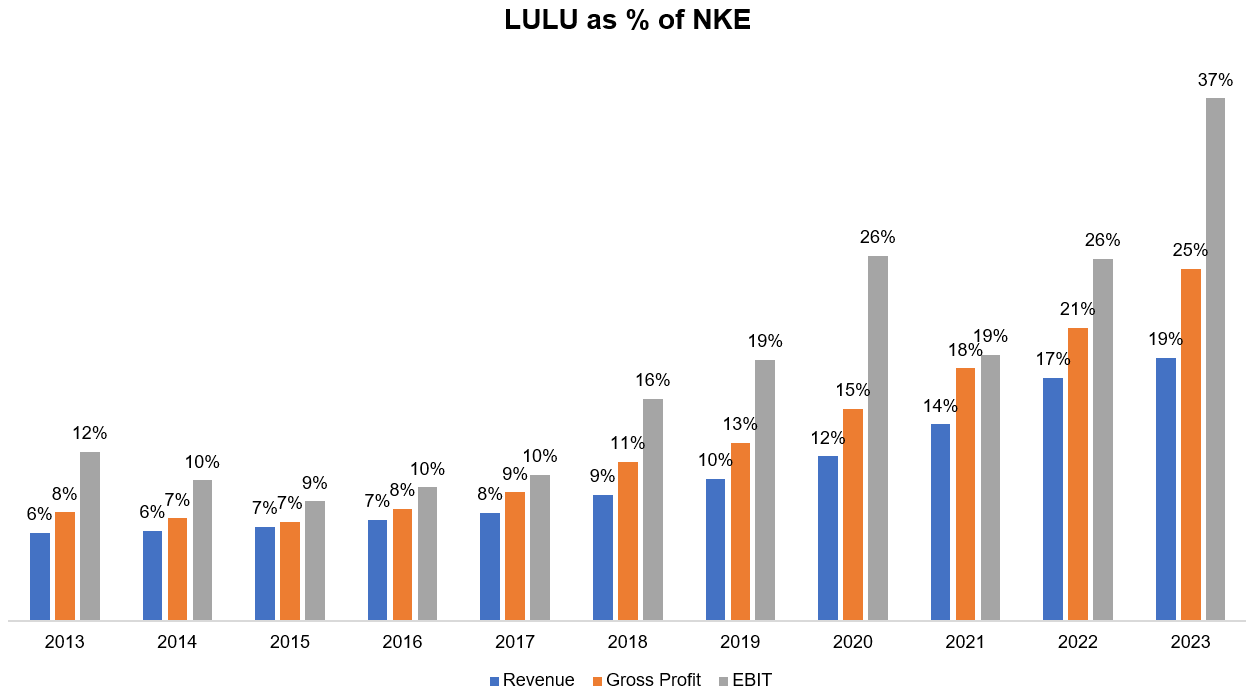
하이라이트:
룰루레몬의 초기 열광은 커뮤니티 기반 마케팅 전략과 명확한 목적을 가진 오프라인 매장 구성에서 비롯되었습니다. 앰버서더와 룰루는 상호 이익의 공생 관계를 형성합니다. 모든 오프라인 매장은 브랜드만의 독점적 경험을 구축·육성·강화하는 데 초점을 맞추고 있으며, 이러한 오프라인 경험이 온라인 채널 전환의 기반이 되었습니다.
2023년 룰루레몬의 매출은 나이키의 20%에 불과하지만, 영업이익은 나이키의 30~40% 수준을 차지합니다. 룰루레몬의 높은 수익성과 효율성은 나이키 광고비의 10%만을 쓰고 있기 때문이며, 이는 커뮤니티 기반 마케팅 전략과 세로형(버티컬) 통합 리테일 구조가 큰 효과를 발휘했음을 방증합니다.
패션은 빠르게 흥했다가 사라지곤 하며, 대개 단기적 사회 트렌드에 의해 움직이고 기능적 필요와는 거리가 있습니다. 반면 메가 트렌드는 더 오래 지속되며 시간이 흐를수록 강해지고 실제 문제를 해결합니다. 룰루레몬은 이미 패션 아이템을 넘어 대중적 메가 브랜드로 전환을 완료했습니다.
서론
룰루레몬(이하 룰루)은 한때 매우 뛰어난 기업으로 꼽혔습니다. 2005년 룰루의 매출은 4,070만 달러였으며, 15년 후에는 100배 성장해 연평균 성장률이 35%에 달했습니다. 같은 기간 아마존의 연평균 성장률이 28%였음을 감안하면 상당한 수치입니다.
하지만 그들이 만든 신화는 주춤하는 듯합니다. 2023년 말 룰루의 시가총액은 648억 달러로 사상 최고치를 찍었지만, 이후 주가는 줄곧 하락세입니다. 5월 21일 최고제품책임자(CPO)가 사임을 발표하며 제품·브랜드 조직 개편이 불가피해졌고, 다음 날 주가는 7% 이상 급락했습니다.
동시에 룰루를 둘러싼 핵심 이슈는 OEM 업체들의 공세와 대체 브랜드의 확산으로 기대 매출 성장률이 둔화되었다는 점입니다. 남성 제품이 성장 바통을 제대로 이어받지 못했다는 지적도 나오면서 “대체 브랜드에 밀리고, 남성 시장을 뚫지 못했다”는 우려가 커지고 있습니다.
5월 30일 종가 기준 룰루의 시가총액은 370억 달러로, 고점 대비 278억 달러가 증발하며 40% 이상 하락한 상태입니다. 룰루의 가치는 어떻게 봐야 할까요? 이번 위기를 돌파할 수 있을까요? 지금이 저가매수 기회일까요? RockFlow 연구팀이 답을 제시합니다.
또한 RockFlow는 과거 여러 우량 미주식 기업의 성장사, 현재 비즈니스, 투자 가치를 심층 분석해 왔습니다. 아래 글도 참고해 주세요.
룰루레몬에 대한 초기 열광과 유저 팬덤
1998년 칩 윌슨(Chip Wilson)은 캐나다 밴쿠버에서 룰루를 창업했습니다. 그가 요가 수업에 참석하던 초기엔 참가자들이 얇고 비치는 댄스복—말하자면 남성 스포츠 셔츠와 티셔츠의 미니 버전—을 입고 있는 것을 보고 더 나은 선택지를 제공하고 싶어 했습니다. 그렇게 룰루가 탄생했습니다.
어떤 기준으로 보더라도 룰루의 요가 팬츠는 여성복 시장에 "혁명"을 선사했습니다. 요가족을 타깃으로 시작했지만 순식간에 틈새 시장을 넘어 대중화되었습니다. 패스트 패션이 소비재 시장을 장악하던 시기에 룰루는 다른 길을 택했습니다.
돌이켜보면 룰루의 성장에는 제품, 마케팅, 채널이라는 세 가지 요소 변화가 있었습니다.
제품 측면에서는 “극도로 편안하다”는 점이 요가 팬츠의 핵심이었습니다. 더 중요한 것은 편안함이 패션성을 희생한 결과가 아니라는 점입니다. 편안함과 패션의 공존이 룰루가 사용자에게 매력적으로 다가간 이유입니다. 룰루는 지적 재산권을 보호하기 위해 특수 원단에 대해 특허를 신청했습니다. 그러나 요가 팬츠의 인기가 높아지자 경쟁사들이 속속 시장에 뛰어들었습니다. 기존의 라이벌인 나이키, 언더아머, 리복, 데카트론, 갭의 여성 스포츠 브랜드 애슬레타(Athleta)뿐 아니라, 부오리(Vuori), 알로(Alo) 등 신생 요가 의류 브랜드도 등장했습니다.
결국 혁신만으로는 지속적인 경쟁우위를 확보할 수 없으며, 수십 년에 걸친 룰루의 성장 스토리를 지탱해 주지도 못합니다. 물론 룰루가 여성복 혁신을 촉발하고 새로운 스타일을 전파한 공로는 크지만, 지속 성장의 핵심은 마케팅 전략과 채널 전략에 있습니다.
마케팅 측면에서 룰루는 나이키와 전혀 다른 접근법을 택했습니다. 나이키의 경쟁력은 단순히 더 좋은 품질이 아니라, 세계적인 스포츠 스타의 인정을 받는 능력입니다. 일부는 나이키를 "스포츠 회사가 아니라 마케팅 회사"라고까지 말합니다.
룰루는 이 차이를 초기에 파악했고, 커뮤니티 기반 마케팅 전략을 선택했습니다. 전 세계에 2,000명이 넘는 브랜드 앰버서더가 있으며, 이 가운데 글로벌 앰버서더는 50명 미만입니다. 대부분은 매장 앰버서더로, 지역의 요가 강사나 피트니스 전문가입니다.
앰버서더가 되면 매장에서 무료 요가 클래스를 열고 다양한 주제의 이벤트를 진행합니다. 앰버서더는 신제품과 활동을 가장 먼저 체험하며, 룰루는 디자인과 제품 의사결정에 대한 피드백을 경청합니다. 룰루 매장을 통해 새로운 고객과 교류하며 자신의 비즈니스를 확장할 기회도 얻게 됩니다.
즉, 앰버서더와 룰루는 상호 이익의 공생 관계입니다. 서드파티가 고객에게 제품을 소개할 때, 거액을 지급하는 셀러브리티 광고보다 훨씬 진정성 있게 다가갑니다. 특히 룰루 자체 영향력 덕분에 앰버서더들 역시 충성 팬인 경우가 많아 고객과의 유대가 더 단단해지고 전환율도 높아집니다.
많은 룰루 팬이 매장 앰버서더가 진행하는 클래스에 참여하는 이유는, 룰루 매장이 단순한 쇼핑 공간이 아니라 일종의 커뮤니티, 목적을 가진 공간이기 때문입니다. 앰버서더 기반 커뮤니티 전략은 경쟁사가 모방하기 어려운 룰루만의 차별화 포인트입니다.
채널 측면에서 룰루의 특징은 세로형(버티컬) 통합 리테일 모델입니다. 나이키, 아디다스, 언더아머 등은 타사 매장에서도 제품을 판매하지만, 룰루 제품을 구매하려면 룰루 매장이나 공식 온라인 몰을 이용해야 합니다.
룰루 매장은 크게 네 가지 유형입니다. 1) 전통적인 정규 매장, 2) 테스트 및 단기 운영 목적의 시즌성/팝업 매장, 3) 남성·여성 제품을 모두 판매하도록 확장한 복합 매장, 4) 명상 공간, 오프라인 클래스 등 경험 요소를 갖춘 대형 ‘익스피리언스 매장’입니다.
모든 매장은 독점 경험을 구축·육성·강화하는 데 초점을 맞춥니다. 칩 윌슨은 룰루가 도매가 아닌 세로형 소매를 선호하는 이유로 브랜드 효과 통제력을 꼽았습니다. 또 하나 흥미로운 점은 도매 모델에서는 유통 파트너가 "잘 팔리는 제품만" 계속 공급해달라고 요구하기 때문에, 디자인과 스타일을 혁신하거나 리스크를 감수하기 어렵다는 것입니다. 세로형 리테일 모델을 통해 룰루는 제품과 경험을 완전히 통제할 수 있습니다.
이러한 오프라인 경험은 온라인 채널 확장의 자신감으로 이어졌습니다. 2015~2020 회계연도 동안 룰루는 전자상거래와 DTC(Direct-to-Consumer) 트렌드의 대표적인 수혜자였습니다. 2015 회계연도에 전체 매출의 19%였던 DTC 비중은 2020 회계연도에는 31%까지 확대되었습니다. 더 중요한 것은 높은 온라인 성장률에도 불구하고 수익성이 훼손되지 않았다는 점입니다.
패션 브랜드에서 대중적 메가 브랜드로
룰루가 어떻게 패션을 넘어 대규모 메가 브랜드로 자리 잡았는지를 가장 잘 보여주는 지표는 나이키와의 비교입니다.

위 도표에서 볼 수 있듯 2013~2018년 룰루의 매출과 총이익은 나이키의 6~9% 수준이었으며, 영업이익(EBIT)은 나이키의 10~16%였습니다. 룰루의 영업이익률이 나이키보다 높았기 때문입니다.
그러나 2019~2020년 이후 상황이 급변했습니다. 특히 2023년에는 룰루의 매출이 나이키의 19% 수준이었지만, 총이익은 25%, EBIT는 37%에 달했습니다.
룰루의 높은 수익성과 효율성은 나이키 광고비의 10%만 지출하면서 달성한 성과로, 커뮤니티 기반 마케팅과 세로형 리테일 전략이 유효했음을 입증합니다. 글로벌 톱 스포츠 브랜드인 나이키와 비교해도 최근 3~4년 동안 룰루의 실적은 매우 두드러집니다.
팬데믹 시기 룰루는 옴니채널 리테일러로서 큰 수혜를 입었습니다. 앞서 언급한 것처럼 오프라인 경험을 중시하지만, 동시에 강력한 전자상거래 역량을 갖춘 세로형 통합 리테일러이기도 합니다. 오프라인 매장은 온라인 마케팅 비용(CAC)을 크게 낮춰 줍니다. 실제 공간에서 브랜드를 접한 소비자는 온라인 광고에 대한 신뢰도가 높으며, 매장은 BOPIS(온라인 주문 후 매장 픽업)와 BORIS(온라인 주문 후 매장 반품) 서비스도 지원합니다.
결국 룰루의 세로형 통합과 옴니채널 경험은 장기 경쟁에서의 지속적 우위를 만들어 냅니다.
물론 알로(Alo), 부오리(Vuori) 등 신흥 브랜드의 도전도 만만치 않지만, 룰루가 패션 아이템을 넘어 대중적 메가 브랜드가 되었다는 사실을 과소평가해서는 안 됩니다. 이들 신흥 브랜드는 자체 틈새 시장에서 성과를 낼 수 있지만, 룰루의 구조적 우위는 훨씬 큽니다.
룰루의 지난 10년 매출 성장률만 봐도 명확합니다.
2024년은 룰루에게 조정의 해입니다. 경영진은 올해 매출이 낮은 두 자릿수 성장을 기록할 것으로 전망했는데, 최근 주가 하락의 직접적인 원인입니다. 이는 최근 몇 년간 20~30% 성장률에 익숙했던 시장의 기대가 너무 높았기 때문입니다. 2021~2022년에 너무 빨리 성장했기에, 이제는 성장 속도 둔화를 소화할 완충 기간이 필요합니다.
임원 교체와 최근 논란
최근 룰루는 수년간 재직한 최고제품책임자(CPO) 썬 초(Sun Choe)가 새로운 도전을 위해 회사를 떠난다고 발표했습니다. 글로벌 크리에이티브 디렉터가 그의 역할을 맡게 되며, 회사는 글로벌·지역 시장을 확장하기 위해 새로운 마케팅·브랜드 조직을 구성하고 있습니다. 니키 누버거(Nikki Neuburger)가 최고브랜드책임자(CBO)로 임명됐습니다.
보도자료에서 시장의 궁금증을 자극한 문장이 하나 있었습니다.
“전략적 조직 개편은 단기·장기 성장 계획을 지원하고, 제품 혁신을 가속하며, 마케팅 전략을 뒷받침하기 위함입니다.”
룰루는 오랜 기간 시장 트렌드에 발맞춰 신제품을 제때 선보이며 패션 사이클을 능숙하게 관리해 왔습니다. 이 문장은 문제의 본질이 지난 분기 컨퍼런스콜에서 언급된 재고 부족 같은 세부 이슈가 아니라, 나이키가 겪고 있는 문제와 유사한 측면—제품 혁신과 브랜드 파급력 강화—에 있다는 점을 시사합니다.
공정하게 보면 룰루의 주가수익비율(PER)은 현재 수년 내 최저 수준이며, 장기 성장 계획은 여전히 견고합니다. 실적이 기대에 못 미친 것은 소비재 전반의 지출 둔화라는 거시적 환경 탓도 있습니다.
사실 2010~2012년에도 유명 헤지펀드 매니저가 룰루를 공매도하며 “결국 요가 패션은 유행이 지나 사라질 것이고, 고 밸류에이션은 거품으로 드러날 것”이라고 주장한 바 있습니다.
하지만 지금 돌아보면, 당시 요가 패션 트렌드에 기대어 성장한다고 평가받던 룰루는 이미 오래전에 지속 가능한 비즈니스를 구축한 대중 브랜드로 자리매김했습니다. 현재 CEO 캘빈 맥도널드(Calvin McDonald)는 룰루를 “테크 웨어(Tech Clothing)”라고 부르길 선호합니다.
룰루는 기존 여성 고객층을 넘어 남성 고객을 적극 공략 중입니다. 다양한 남성용 스포츠·캐주얼 팬츠, 재킷, 악세서리, 신발 등을 출시해 반응을 살피고 있습니다.
글로벌 확장도 가속화되고 있습니다. 2010년 11개에 불과했던 북미 외 매장 수는 현재 255개로 늘었고(전체 매장은 133개에서 686개로 증가), 신흥시장(특히 중국)은 단계적으로 성장 둔화를 겪을 수 있지만 장기 확장에는 큰 문제가 없을 것으로 보입니다.
결론
패션은 대개 단기적 사회 트렌드에 의해 빠르게 흥망성쇠를 겪으며, 기능적 필연성보다는 유행에 좌우됩니다. 반면 메가 트렌드는 더 오래 지속되며, 시간이 지날수록 영향력이 커지고 실질적인 문제를 해결합니다.
룰루레몬은 이미 트렌드 브랜드에서 지속 가능한 비즈니스로 성장했음을 입증했습니다. RockFlow 연구팀은 룰루가 뛰어난 기업이라고 봅니다. 운영 능력이 우수하고, 브랜드도 글로벌 리테일 업계에서 가장 탄탄한 축에 속합니다.
룰루는 이번 분기 실적을 미국 주식 시장 마감 후 수요일에 발표할 예정입니다. 시장은 매출 21억 9,800만 달러(전년 대비 +9.9%), 주당순이익(EPS) 2.42달러(+6.0%)를 예상합니다. 1년 전과 비교하면 성장률이 크게 둔화된 모습이며, 소비재 분야가 전반적으로 어려운 상황입니다. 나이키와 룰루를 포함한 스포츠 브랜드들은 올해 많은 도전에 직면해 있습니다.
이번 실적 발표에서는 미국 시장의 성장률과 전망, 중국 등 신흥시장의 매출 성장률과 비중이 주된 관심사입니다. 2023년 룰루의 미국 시장 매출 성장률은 11.9%에 그쳤지만, 중국 시장은 67.2% 성장하며(2022년 대비 2배) 전체 매출 비중이 7%에서 10%로 증가했습니다.
물론 룰루의 미래 성장 경로에는 다양한 도전이 기다립니다. 규모가 커지고 요가를 넘어 다른 시장과 제품으로 확장하면서, 언젠가는 나이키·아디다스와 보다 직접적인 경쟁에 직면할 것입니다.
저자 소개
RockFlow 연구팀은 미국 주식시장의 우량 기업뿐 아니라 라틴 아메리카, 동남아시아 등 신흥시장과 암호화폐, 바이오테크 등 고성장 산업을 장기적으로 분석합니다. 팀의 핵심 구성원은 Facebook, Baidu, ByteDance, Huawei, Goldman Sachs, CITIC Securities 등 주요 기술 기업과 금융 기관 출신이며, MIT, UC 버클리, 난양공대, 칭화대, 푸단대 등 세계 유수 대학 출신으로 이루어져 있습니다.
다음 플랫폼에서도 저희를 만나보실 수 있습니다: